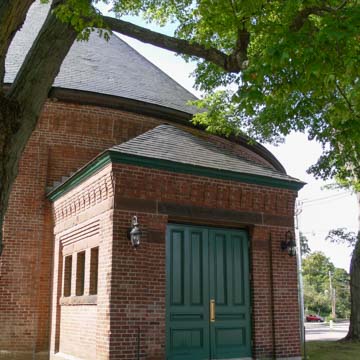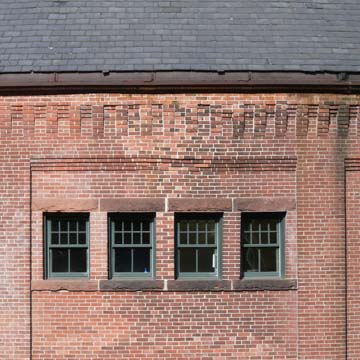From the late nineteenth to the early twentieth century, the Attleborough Falls Gasholder Building contained an apparatus that stored and distributed manufactured coal gas to businesses and residences in the town of North Attleborough. This cylindrical brick structure survives as one of Massachusetts’s six remaining gasholders, which were once a common element of American urban industrial and residential landscapes. Consequently, the Attleborough Falls Gasholder Building presents a rare and significant vestige of an earlier, and largely forgotten, energy regime. The building represents both the development of the town of North Attleborough as well as the history of America’s increasing reliance on fossil fuel consumption.
As North Attleborough’s industries proliferated and population grew in the late nineteenth century, coal gas production rose to satisfy customers’ demand for brighter, cheaper illumination. The physical evidence of this growing consumption materialized in gasholder buildings, which were crucial to the coal gas supply chain infrastructure. In the twentieth century, new fossil fuel products and distribution technology rendered manufactured coal gas obsolete and erased most of the physical evidence of its consumption from the above-ground built environment.
Attleborough Falls is a village within North Attleborough, which separated from Attleborough and incorporated in 1887. Located thirty miles south of Boston, Attleborough emerged as an industrial center over the course of the nineteenth century and eventually became one of leading jewelry producers in the United States. North Attleborough was largely agricultural through the first half of the nineteenth century, but factories began exploiting the Ten Mile River for waterpower beginning in the early nineteenth century. In Attleborough Falls, the brothers Obed and Otis Robinson founded in 1807 what many consider the nation’s first jewelry factory.
The Civil War helped to spur the development of the Attleborough Falls’ jewelry and metalworking industries as the army commissioned large numbers of badges, emblems, and assorted metal goods. In the late nineteenth century, Attleborough Falls rapidly developed into an urban landscape characterized by a typical nineteenth-century mixture of industrial buildings, worker houses, and more substantial residences. In 1892, streetcars linked the area to a regional network of businesses and industries, thus beginning a process of suburbanization that continued through the twentieth century.
The North Attleborough Gas Light Company formed in 1855 to manufacture and distribute coal gas to local industries in need of reliable, bright illumination. Europeans discovered and used coal gas, created by burning coal and purifying the resulting emissions, as early as the late seventeenth century, but the United States did not adopt it until the 1810s. By the 1830s, many American cities employed the gas to light streetlamps. Factories began linking into coal gas networks due to the fuel’s relatively low price and the brilliance of the light it produced. By the 1850s, municipal and private gas works provided light to businesses and homes in over fifty U.S. cities. Domestic use, though, required an expensive installation of pipes, limiting its residential application to wealthy homes, many of which utilized whale oil and, later, kerosene for lighting.
The North Attleborough Gas Light Company originally supplied only local manufacturers with coal gas. As the town’s fortunes and residential development escalated in the late nineteenth century, demand for the illuminant rose significantly in the larger region. Lacking capacity, the North Attleborough Gas Light Company could no longer issue coal gas directly from the point of production to that of use, but instead had to store gas in intermediary holding tanks known as gasometers or gasholders. Gasometers consisted of two primary components: a wrought-iron tank filled with water and inverted bell filled with coal gas. Pipes leading from the coal gas manufacturer fed gas into the bell, which floated atop the water, thus creating an impermeable seal. The bell, attached to the tank by rollers, rose and fell in the water according to the amount of gas held within. Another pipe fed the gas out to the points of consumption. The weight of the bell provided the pressure needed to deliver the gas through the outgoing pipes.
In 1882, the North Attleborough Gas Works constructed its third gasometer—the Attleborough Falls Gasholder Building—in order to expand its distribution network. The company sheathed the wrought-iron technical components in an attractive brick structure topped with a shingled, conical slate roof and an octagonal cupola. The building contains decorative features such as corbeled brickwork at the roof line and pilasters alongside the twelve windows, each of which has a brownstone lintel. The masonry exterior served the practical purposes of protecting the valuable equipment and keeping the water inside from freezing. Moreover, the company intended the pleasing exterior to mask the building’s dangerously explosive contents. Attention to ornamental details also reflected the company’s desire to render the building aesthetically appropriate for its setting. The structure stood on the intersection of Elm and Mount Hope streets, the former of which was an important connecting road. While not a primary commercial or civic center, by the 1880s, this area contained the town’s largest cemetery, Mount Hope; a large gold-plated chain manufacturer, J. E. Slurdy and Sons; a scattering of residences; and a small primary school. The new gasholder was roughly equidistant from Attleborough Falls’s village center and North Attleborough’s main thoroughfare.
The North Attleborough Gas Company continued to manufacture coal gas into the twentieth century, although it switched to purchasing gas from the Taunton Gas Works in the 1940s. The Attleborough Falls Gasholder Building remained in use until the rising availability and falling costs of natural gas and electricity ultimately put the company out of business in the early 1950s. It lay dormant until the 1990s, when developers converted it into office space. The building, which retains its exterior integrity, has become a prominent icon of Attleborough Falls’s history, and was included on the National Register of Historic Places in 1996.
Gasholder buildings were visually prominent elements of a coal gas manufacturing and distribution chain. In contemporary American society, such infrastructural components are relegated to industrial zones at the margins of cities of towns or buried beneath the streetscape and out of sight to most people. While this gasholder did not stand in the center of town, it still occupied a fairly prominent location on an important road near many businesses and residences. Thus, the Attleborough Falls Gasholder Building possesses great significance as a visible and material connection to the origins of, transformations in, and reliance on fossil fuel consumption in America. It offers a space for reflection on how American industrialization and urbanization went hand-in-hand with the increased usage of fossil fuel, which has resulted in the depletion of natural resources and significant, and unintended, environmental consequences.
References
Siergiei, Dianne, “Attleborough Falls Gasholder Building,” Bristol County, Massachusetts. National Register of Historic Places Registration Form, 1996. National Park Service, U.S. Department of the Interior, Washington, D.C.
Jones, Christopher. Routes of Power: Energy and the Making of Modern America. Cambridge: Harvard University Press, 2014.












